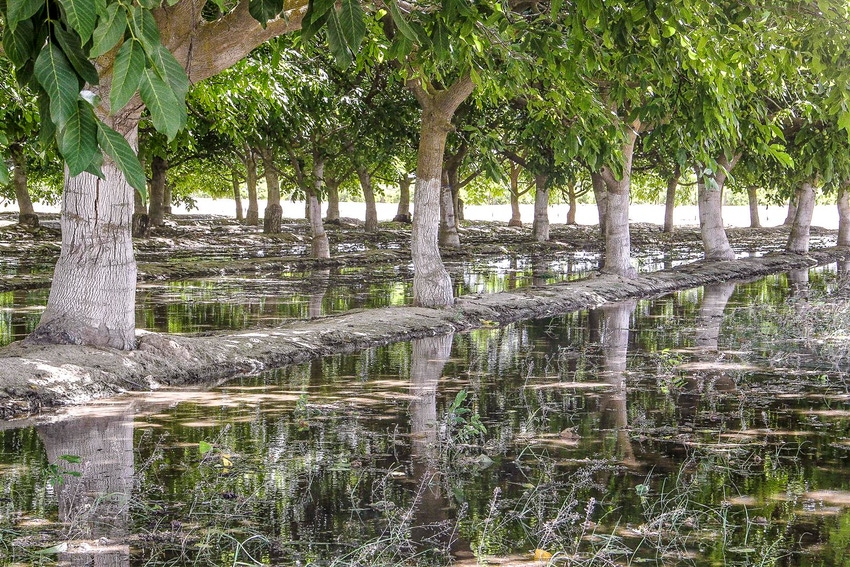
Botryosphaeria a 'sleeping giant' in walnuts
Botryosphaeria called a “sleeping giant” because it can be "roused" by various agronomic practiceIt is a fungal disease, causing die-back in shoots and fruiting budsSymptoms not easily recognized: can be mistaken for branch wilt

Walnut growers face a “sleeping giant” in their orchards that can be roused by rain, irrigation or simple agronomic practices such as pruning.
Botryosphaeria is a fungal disease that causes die-back in shoots and can kill fruiting buds, which leads to lost production and tree health issues, says Themis Michailides, plant pathologist with the University of California. Michailides spoke on the topic during the Tri-County Walnut Day in early February in Visalia, Calif.
Michailides says the disease is not new. A symposium on walnuts in 1915 discussed the disease, he said.
More in Western Farm Press
Virus slams 2013 California tomato yields
Six ways to get your almond orchard ready for bloom
Herbicide-resistant weeds a growing problem
The reason he calls this a “sleeping giant” is because its symptoms are not easily recognized and it has the ability to access trees through walnut scales and pruning. It’s one of those diseases that is more insidious than the others, and can benefit from the effects of walnut blight and the lesions caused by scales.
Additionally, the disease has sometimes been misdiagnosed as branch wilt and has possibly not been taken as seriously as it should. Four of the 10 species of Botryosphaeria are very aggressive, he said.
While panicle and shoot blight, caused by a Fusicoccum sp. (e.g. Botryosphaeria dothidea), is the most serious disease of California pistachios, studies seem to indicate that walnuts are impacted somewhat differently by Botryosphaeria than pistachios.
For instance, green fruit and walnut leaves tend not to be as impacted by Botryosphaeria when compared to pistachios. This needs to be studied further, he said.
Still, the disease can cross back and forth from pistachios to walnuts to almonds, Michailides says. It’s just that it has its differences in how it gets into the various trees and the symptoms it displays. Making it more difficult is symptoms of the disease are difficult to spot in walnuts.
Wounds open pathway
In walnuts, Botryosphaeria likely needs a wound in the tree to gain access. This is different than in pistachios. That is why Michailides says healthy green walnuts and healthy walnut leaves may not be places where the disease can access the tree. Botryosphaeria attacks sunburned walnut branches, killing them and converting the fungus to spores which can be easily spread by water or insects.
Lesions on walnut fruit caused by blight, or the scars left behind when blighted walnuts fall from the tree are like open sores and can allow access of Botryosphaeria spores into walnut trees. The scaring left behind by scales is also an open door to the fungus. Further studies will need to be completed to assess the effects of walnut blight on Botryosphaeria infection.
Michailides has photographs showing the die-back of stems once the disease enters the tree. In some pictures it shows dead stems upwards of four inches from where a blighted walnut fell from the tree and created an open sore for the Botryosphaeria spores to enter.
Terminal spurs will die close to harvest and post-harvest. These spurs contain the buds for the following year’s crop. In one case he saw a dead spur that took with it seven fruiting buds.
That is why addressing scales in walnuts is important, he said. While scales may not necessarily cause production losses or other problems in walnuts, the lesions they leave behind are the open sores Botryosphaeria can enter. According to his studies, 60-75 percent more shoots were infected with Botryosphaeria when scales were present than when they were not.
The good news is that some fungicide controls already available in pistachios seem to reduce Botryosphaeria infections in walnuts.
Rain and sprinkler irrigation where water is splashed on low-hanging branches can spread the disease, he said. Under dry weather conditions such as the current drought, symptoms can go undetected until harvest and post-harvest.
In a separate talk at the Tri-County Walnut Day on Thousand Cankers Disease in walnuts, Tulare County Farm Advisor Elizabeth Fichtner drew a connection between issues that exacerbate this disease and Botryosphaeria.
Fichtner said walnut cut and sold for firewood has been found to contain Botryosphaeria. Its movement around local areas and throughout the United States not only moves around the Walnut Twig Beetle, which is responsible for vectoring Thousand Cankers Disease, but can help spread Botryosphaeria.
Moreover, the act of cutting the firewood and small limbs can cause Botryosphaeria spores to become airborne.
Fungicide trials she conducted with Michailides in Tulare County turned up positive samples of Botryosphaeria in walnut orchards.
About the Author(s)
You May Also Like





